In the vast expanse of the cosmos, a grandiose event is brewing in the Corona Borealis constellation. T Coronae Borealis, a star situated over 2,500 light-years away, is preparing to unleash a magnificent explosion that will momentarily transform it into one of the brightest entities in the nocturnal heavens. This celestial phenomenon has astronomers eagerly anticipating the spectacle, not only for its visual splendor but also for the invaluable data it will provide on a specific kind of stellar outburst known as a classical nova.
The impending explosion of T Coronae Borealis, affectionately known as T CrB, is no random occurrence. This star has exhibited the tendency to erupt periodically, with a recurrence every 80 years continuously for at least eight centuries. This predictability offers a rare opportunity for scientists to witness an event that occurs once in several lifetimes. Additionally, the technological advancements in observational tools since the star’s last eruption in February 1946 ensure that this forthcoming display will be scrutinized in unprecedented detail.
Classical novae, such as the one anticipated from T CrB, differ from the catastrophic demise of stars in supernova explosions. Instead, these events result in smaller eruptions that leave the star predominantly intact. The recurring explosions of T CrB stem from its unique composition as a binary star system housing a white dwarf, a highly dense remnant of a Sun-like star, alongside a red giant companion.
The cyclical explosions of T CrB are fueled by an intricate interplay between the white dwarf and its neighboring red giant. The white dwarf’s intense gravitational pull draws in hydrogen-rich material from the companion star, accumulating a highly compressed layer of hydrogen on its surface. When the pressure and heat within this layer reach a critical point, a runaway thermonuclear reaction ensues, triggering a spectacular expulsion of excess hydrogen into space in a fiery display known as a nova. For T CrB, this explosive process unfolds approximately every 80 years.
Over the past decade, astronomers have observed telltale signs within the T CrB system indicating an imminent eruption, reminiscent of the prelude to the 1946 explosion. Speculations suggest that the event could transpire before September 2024, prompting vigilant monitoring of the star system. Positioned amidst constellations like Lyra, Hercules, and Boötes, the Corona Borealis region is poised to herald the stellar bloom that will captivate observers worldwide. Citizens are encouraged to contribute to data collection efforts, enhancing our understanding of these enigmatic cosmic episodes.
As the countdown to the T CrB explosion continues, astronomers and citizen scientists alike are poised to turn their gaze towards the heavens, awaiting the momentous event. With an array of telescopes spanning various wavelengths prepared to capture the phenomenon, the collaborative effort promises to unravel the mysteries of recurrent novae. In the words of astrophysicist Koji Mukai from NASA Goddard, “Recurrent novae are unpredictable and contrarian,” underscoring the intrigue and complexity of these celestial occurrences.


Leave a Reply